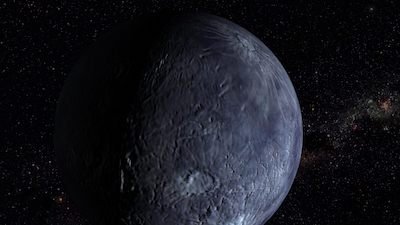
Mysterious Icy Objects found In Solar System
A mysterious group of icy objects in our outer solar system is covered in “fresh powdery ice” and looks as though it is “no more than 100 million years old”—a far cry from the supposed age of a billion years.
News Source
- New Scientist: “Mysterious ‘Bright Young Things’ Found in Solar System”
The family of objects has been discovered in the last three years, but the objects are traveling in orbits that indicate “they probably formed in a collision more than a billion years ago,” explains New Scientist.
A team led by Yale University’s David Rabinowitz reported that the brightness of the objects changed little when observed from various points as earth travels around the sun, suggesting the objects are covered in a consistent layer of fresh ice. Scientists believe “space weathering” over time colors ice-covered surfaces over time as ultraviolet radiation and cosmic rays break down the ices, leaving dark, reddish carbon compounds.
The battle over origins is not about who has more “evidence” for their theory.
Of course, this finding looks like yet another that seems to go against an old age for the solar system, yet, sadly, we don’t see old-age astronomers adapting their ideas to account for even the possibility of a younger universe. This illustrates that the battle over origins is not about who has more “evidence” for their theory; any time such “evidence” comes along that seems to go against evolution (or even creation), evolutionist (or creationists) say “wait and see” and hold out for an explanation of the facts that fits their worldview. That is why, even among many natural processes that seem to support a recent origin of earth and the universe, so many hang on to old-earth and old-universe beliefs. It is because those groups have an a priori commitment, in their worldview, to extreme age. Thus, supposedly objective scientists do not “follow the evidence wherever it leads” (which they claim only creationists can’t do); they interpret and assemble the facts into a paradigm, and when something contradictory to the paradigm is discovered, they either interpret it through a “rescuing device” or have faith that someone will eventually propose an answer that explains the contradictory discovery.
Likewise, young-earth creationists have an a priori commitment to the Bible, which teaches a young age for the earth and the universe. There is much evidence to support this view, but ultimately, it comes down to our presuppositional commitment to God’s Word.
Further Reading
- The Key to the Age of the Earth
- What is the most compelling scientific evidence of a young earth?
- A young Earth—it’s not the issue!
For More Information: Get Answers
Remember, if you see a news story that might merit some attention, let us know about it! (Note: if the story originates from the Associated Press, FOX News, MSNBC, the New York Times, or another major national media outlet, we will most likely have already heard about it.) And thanks to all of our readers who have submitted great news tips to us. If you didn’t catch all the latest News to Know, why not take a look to see what you’ve missed?
(Please note that links will take you directly to the source. Answers in Genesis is not responsible for content on the websites to which we refer. For more information, please see our Privacy Policy.)
Recommended Resources

Answers in Genesis is an apologetics ministry, dedicated to helping Christians defend their faith and proclaim the good news of Jesus Christ.
- Customer Service 800.778.3390
- Available Monday–Friday | 9 AM–5 PM ET
- © 2025 Answers in Genesis





